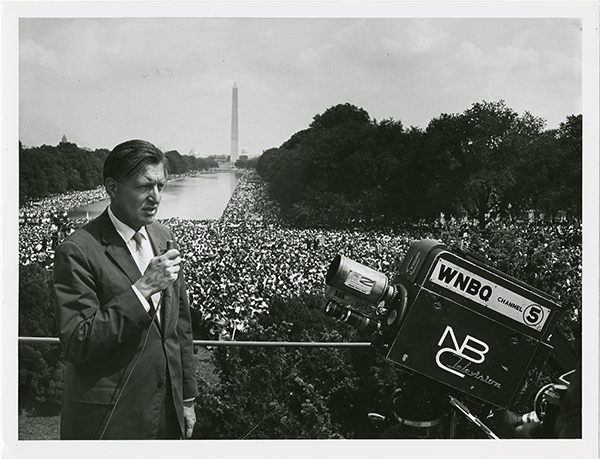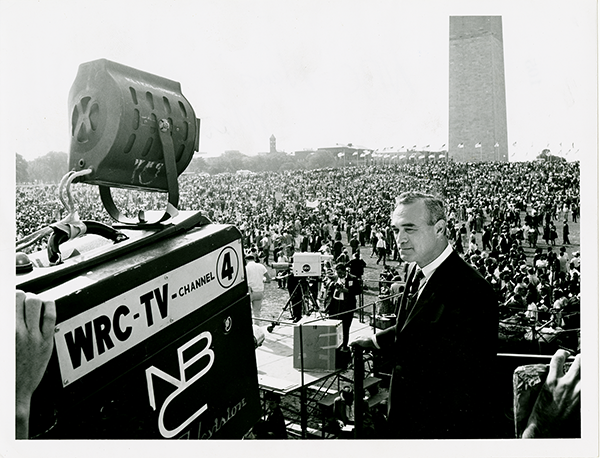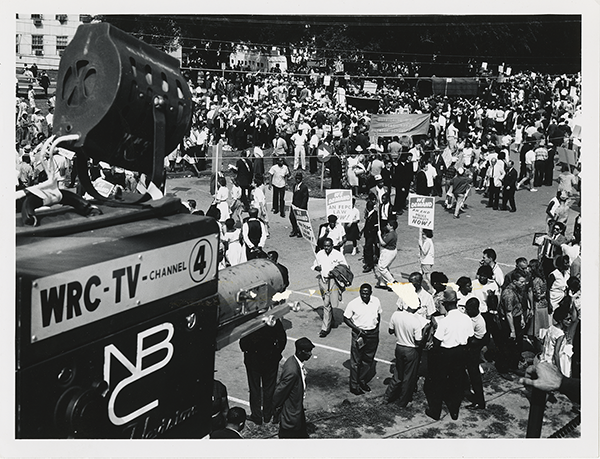Anarchy or Activism: Demonstrations and the Media
News broadcasters can play a very important role in interpreting the events around them. Protest demonstrations offer a particular challenge for broadcasters, given the large scale and heightened emotions. Broadcasters may inadvertently shape the public's understanding of an event by attributing the action as something positive, like activism, or something negative, such as anarchy. Curators of our media collections selected material that demonstrates the ways broadcasters reported past demonstrations.
Listen to radio coverage
Dating from the late 1960s and early 1970s, these tapes provide a rare audio snapshot of radio journalism during an era of cultural and political turmoil in the U.S. Many of the issues highlighted in these broadcasts are resurfacing today, which offers the opportunity to compare how the media’s role in reporting unrest and dissent has both endured and changed.
These historical audio clips have survived thanks to Gordon Greb, a broadcast educator, historian and investigative journalist who recognized the value of preserving broadcast history. Among his many career accolades, Greb was one of the founding members and coordinators of the Graduate Program in Mass Communications in San Jose State University’s School of Journalism, and served as a professor there until his retirement in 1990.
When he was chairman of the California Associated Press Television Radio Awards committee, Greb saved nearly all of the reel-to-reel tape recordings of news programs and documentaries that were entered by California stations, and donated them to the Broadcast Pioneers Library (BPL) in 1983.
Attempt to Commandeer College Radio Station
KSJS - October 28, 1966
Oakland Draft Demonstrations
KCBS - October, 20, 1967
Special Report on Police and Demonstrations
KPFA - October 24, 1967
Spectrum News Report on Police Action Against News Media
KSJS - May 4, 1970
Images of broadcasting coverage
Recent events remind us that the National Mall in Washington, DC has a long history as the site of political protests, demonstrations and other forms of civic engagement. One of the most significant marches was the March on Washington for Jobs and Freedom that took place on August 28, 1963. In an era before the 24/7 news cycle, the broadcast media provided extensive coverage of the march.
The three major U.S. radio and television networks (ABC, CBS, and NBC) broadcast around the clock coverage of the march. The NBC network devoted 17 hours of coverage to the march, starting with the Today Show at 7 a.m. and concluding at midnight with a news special interviewing march organizers. In all, ten NBC correspondents were involved in the coverage including Frank McGee, Nancy Dickerson, Ray Scherer and Martin Agronsky, among others.
The following photographs from the Don West Broadcasting & Cable Photo Archive showcase NBC coverage of the March.
Click on photos to view larger versions.
NBC correspondent Ray Scherer overlooks the vast crowds attending the march as he speaks into a camera provided by WNBQ (NBC, Chicago)
NBC correspondent Martin Agronsky reports from the Washington Monument via WRC (NBC, Washington, DC).




